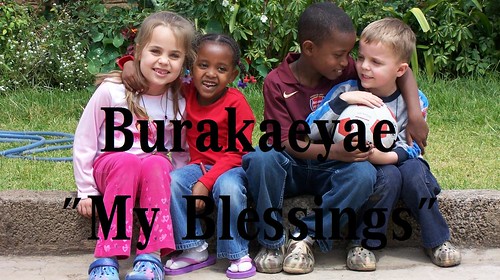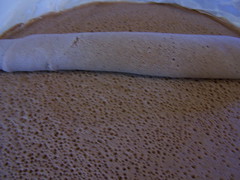This past weekend I made my yummiest injera ever and want to share with my readers the slight variations I made to the basic instructions. This injera included barley flour which gave it a taste just like what I've had in the Ethiopian restaurants in NC.
If you didn't read the post where I gave basic instructions, check that out first. These are very step-by-step instructions for making authentic Ethiopian injera here in America.
But first, a tip for getting more ain in your injera: The first step I gave in my instructions was "The Night Before" step. If you pull the starter out of the refrigerator earlier in the day and feed it with some wheat flour (just because it's cheaper- use whatever flour you prefer) in the morning, then give it another feeding in the afternoon, it will have more ain when you cook it the next day.
Now, to incorporate barley (gebs for my Habesha readers!), here is how I did it. I'm sure you can experiment on your own for variations. But I'll tell exactly how I did it since it worked for me.
When I did Step 1 (The Night Before), I added teff and kneaded it exactly as is written in my basic instructions. However, prior to adding teff, I set aside half of the starter. I had 3 cups of starter that I divided into 3 separate plastic containers. I kneaded teff into 1 cup of starter. Then I "fed" 1 cup with barley. And I fed the other cup of starter with self-rising. I did not knead the barley and self-rising. I just fed the starters. If you don't know how to feed a starter, please see my post about making and feeding starters.
The next morning I fed the barley and self-rising again. Then I made sure I had equal amounts of teff, barley, and self-rising starter. I blended it all up in the blender, just as my basic instructions say to do. Everything else I did was the same.
The reason for making the barley and self-rising into a starter the night before is that it adds to the sourness of the injera. Also, it allows more time for the ain to develop.
I have thoroughly enjoyed all of the emails I've received from people who are experimenting with their own injera. I must say though that my favorite emails have been the ones I've received from Ethiopians. I got the funniest email this morning from a lady who wanted to tell me all about the funny video she found on the internet. The reason it was so funny to her is that it was a "ferinj lady" teaching people how to make injera! I wrote back and told her that I too think that's hilarious! :) If you've tried injera and it still didn't work, don't give up! Try it again! I've gotten quite a few emails from people who have finally found success. You can do it! :)
Monday, March 05, 2007
Subscribe to:
Post Comments (Atom)



13 comments:
I wanted to de-lurk myself. I found your blog through our friends, the Heldts. We haven't started the adoption process yet, but are very excited for what the Lord has in store for our future. I have so enjoyed reading about your husband's and your own journey to Ethiopia. I am praying that God speedily paves the way for you to be with your Ethiopian children. I have been blessed by reading your experiences. Thank you!
Samantha Markwort
markwort.blogspot.com
Your ferengi comment made me laugh. I told my Ethiopian friend that I bet make the best injera made by a white woman that he has ever eaten. He thought about it for a moment and said that I would win that bet!
I ferment all 3 flours (self raising, barley and Teff) together in the same container and leave it for 2 days. This makes it nice and sour.
Dear Ferinj lady,
Thank you very much. You know I have tried to make it in the past but most ethiopians wouldn't tell you the receipe or if the did they wouldn't tell you completly(don't ask me why) your habesha friend probably told you thinking that you wouldn't know a lot of ethiopians to tell her receipe, little did she know ...:)
By the way, if you are in need of berber or shiro let me know, my in-laws(amat) are coming from addis around may. It is the least I can do:)
The Email Lady
I am posting anonymous because I wanted to quickly reply to your blog. My husband and his family were part of the African diplomatic corp in Ethiopia, OAU, and never learned to to make injera. So currently my sister-in-law and I have been desperately trying to make injera with little or no instructions. I am so happy that you posted your blog, as it has gone from California, to France and back to Africa in the race to be the first in the family to make it right. I truly love your blog and love the recipe. I am making the starter as we speak to we'll se how it turns out. Take care and God bless,
Karen PS We are planning a trip to Addis in August.
That's really stupid thing. Fuck you. Habasha. You guys are beggers.
White Huy
First of all let me say props to you! Yours has to be the most complete instructions on how to make injera in the US. BTW I am Ethiopian and had brought 10kgs of teff from Ethiopia to make injera here. Well I started experimenting about 4 months ago and had almost used up almost all of the teff that I had (mind you, with no success)! I finally came across your blod and I am at step 3 (blended the two lits and put em together. I couldnt wait till this afternoon and decided to make a small trial sample (engocha as it is called...:-) and I already have a beautiful delicious injera for breakfast! It looks like it is going to a success this time!!!!!!!! Thank you gain and will let you know how my injera is going to turn out.
I enjoyed the video. but let me ask can you make it with out self rising flour? The baking soda is horrible to the system.
Thank you Thank you Thank you. I DID IT, I made Injera first try! It was excellent! I am so excited.
I studied your blog for weeks first, to make sure I really knew what to do, I made the starter over 20 days and it all came out perfect. Thank you, when I bring my children home from Ethiopia, they can have some comfort food!
Thank you; thank you; thank you! You rock! I just made my first batch of injera and it came out great! (Well, great for a first try.) I transformed the starter into teff & barley before making the injera. My 4-year old Ethiopian son has a wheat sensitivity, and the injera that the Ethiopian community makes in town (Albuquerque) all has wheat flour in it. Yesssssss! -- Kathy in Albuquerque (Yonas's mom)
hi heather i'm glad you posted this info. i'm Ethiopian and i never new the steps, since i saw your post i will give it a try. Also for the other ppl. on your blogs i have some advise about my ppl. we are very friendly and helpful we share what we know but, because of the climate difference as i said even for my self i had no sucesses in the past. i am thankful for your blogs. keep up the good work.
I commend you for all the effort and sharing it in detail. I have not tried it yet.
Some one commented Ethiopians don't tell you how to make it. Two other Ethiopians were honest enough to say they don't know how to make it. The truth is many Ethiopians may not know how to make it. It is time consuming process, and yet once mastered, it is baked in Ethiopian kitchens back home every three to four days.
I am from the city and most houses have physically separate kitchens on their compounds for Ethiopian kitchen especially Injera baking. It is baked on a wide clay "pan"/around 22 inches on open fire lit with wood. There are people who specialize in Injera baking. You either contract them to come every so often to do just that,or are a part of members of the family and they do that as part of other responsibly.
Along the way, several school attending generation who live in the city have missed out in mastering the craft of Injera baking.
We are additionally sending out other unique items everywhere throughout the world. We are known for the most part for our entrenched global exchanges of Teff and working together principally in the business sectors of USA, Europe, Middle East, India and China. We offer amazing items and incredible transportation administration.
Post a Comment